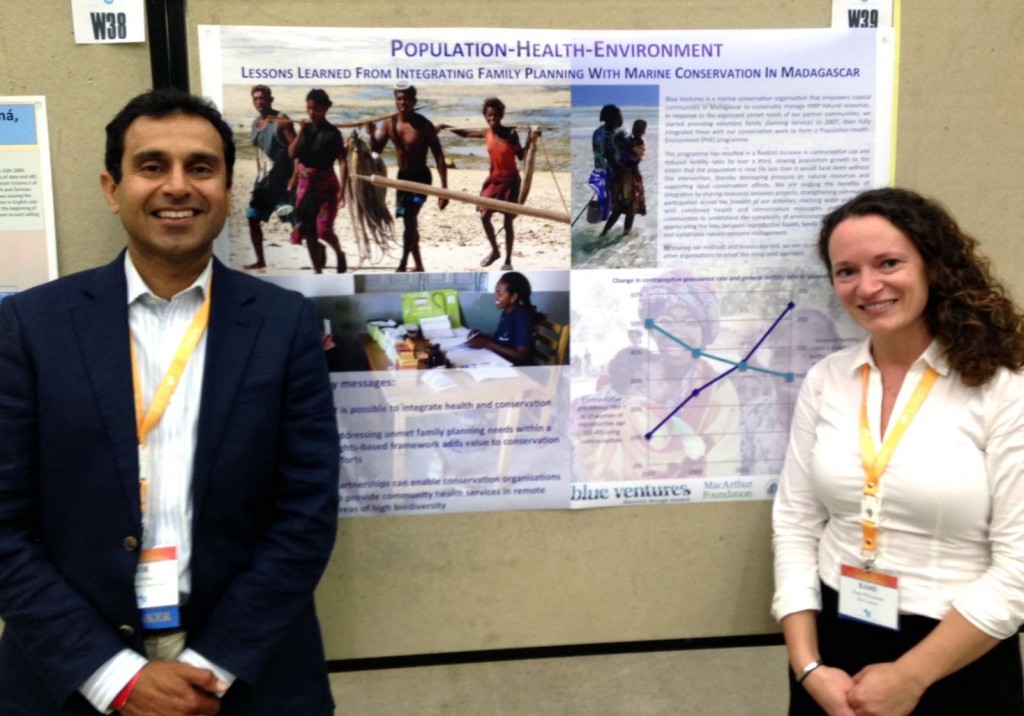By Vik Mohan, Blue Ventures’ Medical Director
I recently returned from a whistle-stop one-week tour of three US cities, where I was working to raise the profile of Blue Ventures’ integrated Population-Health-Environment (PHE) approach, sharing the results of our work, and enthusing our partners about this innovative and powerful model for community-based conservation and development.
My first port of call was Baltimore, where 1,500 delegates were attending the International Congress for Conservation Biology (ICCB). The theme for this year’s conference was “Connecting Systems, Disciplines and Stakeholders – the importance of an integrated approach for conserving and restoring Earth’s biological diversity”. What better example of interdisciplinary working could there be than PHE? It seemed like the perfect platform for presenting our work to the conservation community. Surprisingly though, we were one of only two PHE organisations represented at the conference, and most people’s idea of interdisciplinary working did not extend as far as conservation and health. It reminded me yet again that although the concept of integration and working holistically is practically in Blue Ventures’ DNA, the idea of integrating health and conservation remains a novel concept for the majority of the conservation community.
Despite this, population growth was repeatedly cited as one of the major challenges to biodiversity conservation at the conference. I took every opportunity I could to extol the virtues of integrating health services (and a rights-based approach to family planning in particular) into existing environmental programmes, citing the conservation as well as health benefits. The breadth of responses I received ranged from the I’m-staying-firmly-in-my-silo “we can’t do everything”, to the truly heartfelt “thank goodness someone’s actually addressing this issue: how can I do the same?”
My speed talk (aka “the 4 minute PHE spark!”) was hearteningly well received. A combination of powerful images and an emphasis on the richness and power of PHE really seemed to hit the spot, with lots of enthusiastic discussions, questions, and positive feedback at the end of the session. What was great about giving a presentation as part of a generic “Marine and Wetland” panel was that the attendees had not come to hear about PHE in particular, and I was therefore able to engage a completely new audience on this topic. I lost count of the number of times I heard people saying, “I’ve never come across this idea before”.
It was wonderful to see our good friend and former Blue Ventures colleague Kame Westerman, who gave a talk on building ecological and social resilience to climate change through an integrated approach to conservation and development, and Kame and I delivered two PHE workshops together. We successfully lit fires again, provided attendees with lots of reasons to consider integrating health into their work, and enabling them to develop their own ideas as to how they might do this.
My general impression was that there is a growing awareness among conservation biologists of the need for thinking more broadly about the measures needed to achieve conservation goals. Our presence nudged some of the delegates in that direction, challenged some of them to think the previously unthinkable, and provided them with a concrete example of a successful PHE programme.
In contrast to being almost a lone PHE voice in a world of conservation biologists, going to Washington felt like coming home! It was a great opportunity to reconnect and strengthen relationships with PHE colleagues at the Wilson Center, the Population Reference Bureau, Population Action International, USAID and beyond. It was really good to see that Matt Erdman, our former Safidy Programme Coordinator, has successfully transitioned into his role as PHE Technical Advisor to USAID! After very productive meetings with Linda Bruce from the BALANCED project, and with Roger-Mark De Sousa and Sandeep Bathala from the Wilson Center, I presented on a panel event at the Wilson Center along with Kame Westerman and an inspiring lady called Fatou Janha from the TRY Oyster Women’s Association, who runs a PHE programme in The Gambia. The panel session was entitled “Oysters, Octopus and Resilience”, and the three of us covered different aspects of our respective PHE programmes.
What I took away from Washington was that with the growing awareness our PHE work is receiving on the global stage comes a responsibility to make an appropriate contribution to the field, including publishing our results and supporting the effective evaluation of PHE programmes. The onus falls on us to add to the existing literature and demonstrate the benefits of PHE. It feels more important than ever to produce robust evidence that integration enables more effective (and more cost efficient) achievement of health and conservation goals than single sector interventions.
My final stop was Chicago, where I met with the MacArthur Foundation, an institution that has broken the mould of the siloed approaches to donor funding that so often characterise the conservation and development sectors. The Foundation has been instrumental in supporting the evolution of Blue Ventures’ PHE work in Madagascar, and has also played a key role in the development of our community-based marine conservation programmes and mangrove carbon research. The purpose of this visit was to feedback on the progress that Blue Ventures has been able to make with the Foundation’s investment, and to thank them in person for their continued support.
So, six presentations and five days working days later, I return home with lots to think about. It has become increasingly clear that Blue Ventures has the opportunity to make an important contribution by providing thought leadership from within the conservation community, contributing to ongoing discussions about how PHE develops, and evaluating the value-added benefits of our integrated approach.


